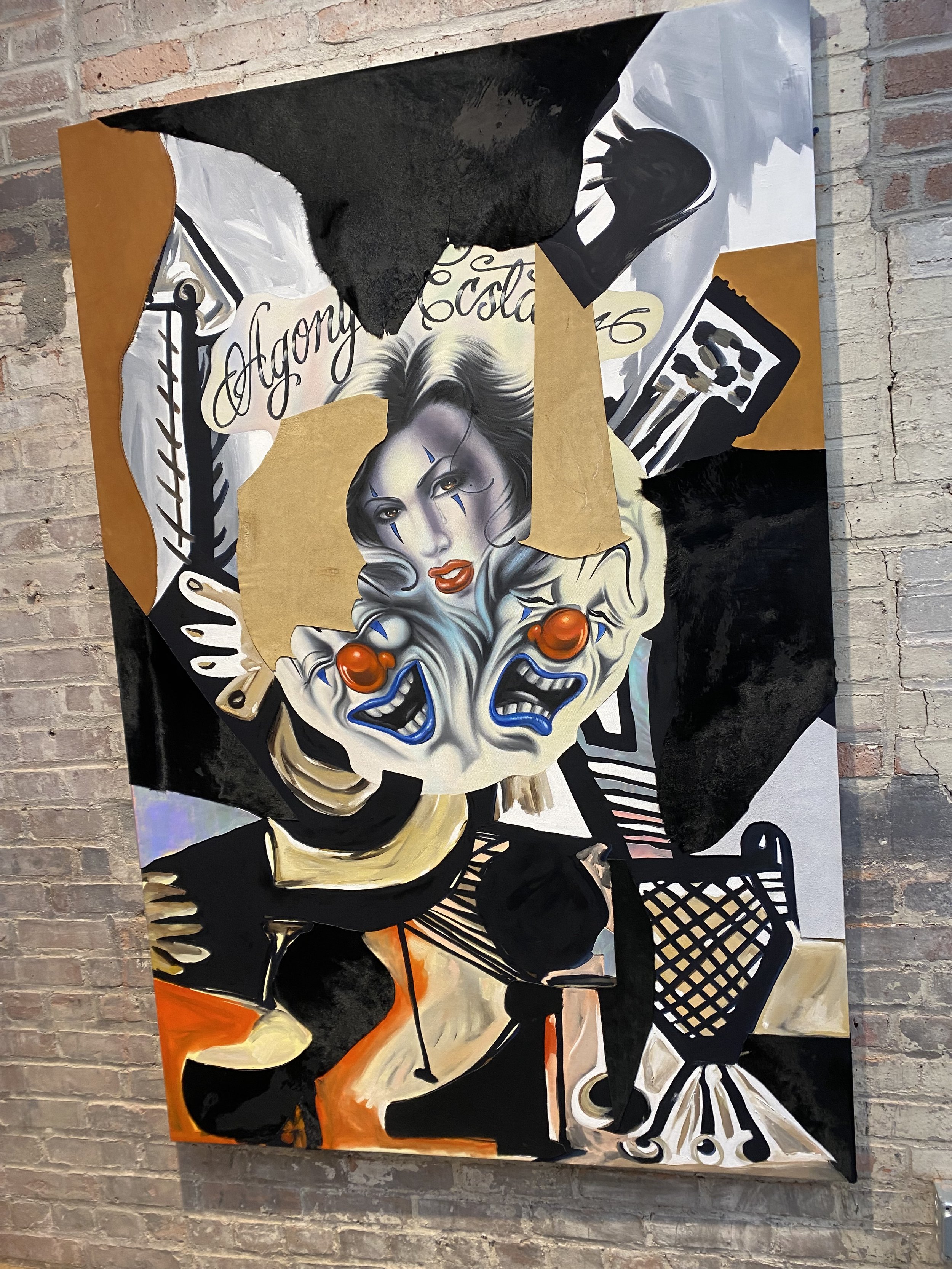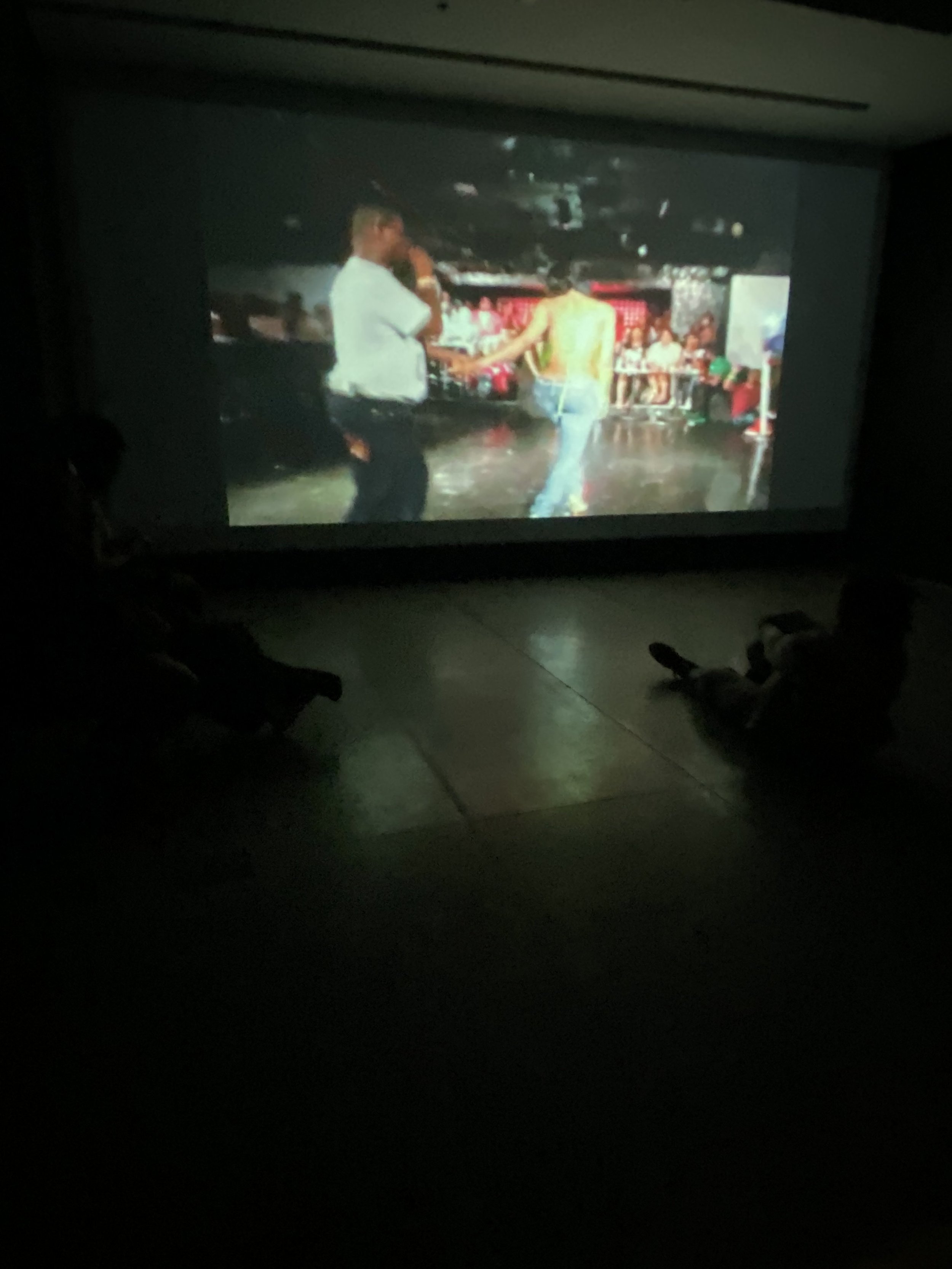ELEVATED ARCHIVES UNDERGROUND TREASURES: Local Global Dixwell
essay by Reggie Woolery, Inner City News . March 22, 2023
NXTHVN, Dixwell, New Haven, CT
Cohort 4 curators Cornelia Stokes and Kiara Cristina Ventura
painting by athena quispe
Captain James Stovall V
Anindita Dutta
LaKela Brown
David Hammons
Video by Arthur Jafa
Sable Elyse Smith
Anthony Akinbola
Sable Elyse Smith
Emmanuel Massillon’s Contemplating Existence
Organized by NXTHVN’s Cohort 04 Curatorial Fellows Cornelia Stokes and Kiara Cristina Ventura, NOT FOR SALE featured artists who reappropriate products like du-rags, bamboo earrings, and corner store food items. The exhibit centers on Black and Brown ways of seeing the world, ascribing prestige, value and affect to everyday materials, moments and in-between spaces read by beauty networks like mainstream galleries and museums as too ghetto.
There are works by Anthony Akinbola, LaKela Brown, David Hammons, Lucia Hierro, Arthur Jafa, Emmanuel Massillon, and Sable Elyse Smith. Entering the gallery, Anthony Akinbola’s silky red field of stitched du-rags holds court. On an adjacent wall, LaKela Brown’s white and gold bas relief painting from bamboo earring impressions, claps back. Sable Elyse Smith feeds us on bricks of ramen, along with oversized sacks of rice and black beans.
American conceptual artist David Hammons is known for repurposing objects like liquor bottles into poetic works that convey a blues aesthetic. In NOT FOR SALE, his necklace of discarded bottle caps hangs from the walk snakelike, sending juju to Emmanuel Massillon’s Contemplating Existence, a hefty wood sculpture affixed front and center with a picture of white Jesus and tourist African totem atop, suggesting folk constructions of spirituality.
Alongside NOT FOR SALE, engaging new works by NXTHVN Cohort 04 Studio Fellows Anindita Dutta, Modupeola Fadugba, Donald Guevara, Ashante’ Kindle, athena quispe, Edgar Serrano, and Captain James Stovall V are on display. Dutta’s sensual fabric sculptures invite touch, even as they convey the precarity of doing so. Edgar Serrano’s paintings raid art historical styles and visual street forms like comics, tattoos, and mural painting to arrest contradictions.
athena quispe’s describes her work as a trans-mutation of her Quechua heritage, a pre-colonial romantic poem set on healing – claiming that the Western gaze has packaged indigenous ways as New Age spiritual concepts. Thus, quispe problematizes materials and enacts ritual gestures to reshape love, labor, and melancholic honesty. Within the exhibition, her paintings disrupt expectations of composition, perspective, and story – calling us to look again, fresh.
At the entrance to the permanent collection at the New Britain Museum, they have placed a contemporary Titus Kaphar oil painting Javann and the Unknown Gentleman, 2011, alongside its colonial inspiration, Gentleman with Attendant, ca 1785. Kaphar, co-founder of NXTHVN, gives a name and dignity to the Black enslaved and silences ‘the gentleman’ who by dress, title, and placement within a portrait, is the economic beneficiary of the slave trade.
Thus, re-appropriation is part of NXTHVN’s essence. Titus Kaphar and Jason Price’s arts incubator is an incredible intervention, much as Noah and Karon Davis’ Los Angeles local global art spot in the hood, the Underground Museum. Here in Dixwell, with galleries, housing, and office spaces re-fashioned from a former factory, revitalizing a neighborhood economy in flux, the modern glass and brick façade also convey the present in the past in the present.






At the Toni N. and Wendell C. Harp Historical Museum at the Dixwell Community House, with support from the Bienecke Library at Yale University is the exhibition TIMELESS: TELLING NEIGHBORHOOD STORIES, focused on New Haven native daughter Constance Baker Motley. The museum’s inaugural exhibit, with the theme of overlooked local history, featured New Haven born, famed New York Congressman Adam Clayton Powell, Jr.
The organizers of this exhibition are Constance Royster, niece of Constance Baker Motley, and Dr. Frank Mitchell. Dr. Mitchell holds a Doctorate in Philosophy from the University of Michigan and was appointed by Governor Ned Lamont to the Board of Connecticut Humanities. He taught at the University of Connecticut, Trinity College, and Franklin & Marshall College, serving as Director Emeritus of The Amistad Center for Arts & Culture.
In TIMELESS, we see images of Constance Juanita Baker at Columbia Law School, out nightclubbing in New York City, with Thurgood Marshall for whom she clerked, standing alongside Dr. Martin Luther King Jr., and attorney William Kunstler in Atlanta, and later being sworn in as Manhattan Borough President. The photos and archival materials weave a portrait of an activist and scholar who was the recipient of a rich community and cultural life.
At the NAACP Legal Defense Fund, Motley led litigation that integrated the University of Georgia, Alabama, and Mississippi among others. She was the first African American woman to argue a case before the Supreme Court, and the first to serve as federal judge. In Baker Motley’s autobiography EQUAL JUSTICE UNDER THE LAW, she credits the Supreme Court in 1841 for acknowledging that non-enslaved Africans were free persons.
It is significant that this ruling involved Motley’s hometown. In 1839 Portuguese slave hunters abducted a large group of African people in Sierra Leone and transported them to Havana, Cuba for auction. The would-be enslaved revolted and attempted to sail the schooner La Amistad back to their homeland.
After two months adrift, the ship was discovered by a federal brig in Long Island Sound and the Mende passengers were imprisoned in New Haven. Abolitionists intervened to keep the ship and cargo from being returned to the Spanish authorities. They also raised funds to hire future Connecticut governor Roger Sherman and former U.S. President John Quincy Adams to argue the case. Seeking basic human rights, they were able to win the release of the Mende with their leader the 25-year-old Sengbe Pieh (known as Cinque). Yet, Motley argues, these lessons of freedom were short lived.
In 1857, just sixteen years later, the Supreme Court “when asked to determine the status of Africans in the American community, the court explicitly noted that our Founding Fathers never contemplated that free Africans would constitute a part of the body politic. The high court said, in dicta, that free Africans in American society had always been regarded as an inferior order of beings and had no rights that ‘a white man was bound to respect.’”
The Harp Historical Museum is named for New Haven’s 50th Mayor, Toni Harp, and her husband Wendell. It was during her tenure that a sculpture was erected on Yale University campus of King William Lanson to commemorate this nineteenth-century pillar of the city and Black community. TIMELESS’s sub-theme “Every day we write the book,” suggests future presentations will focus on lesser-known stars who over the years led community change.
NOT FOR SALE is TIMELESS. TIMELESS is NOT FOR SALE.
One exhibit lifts Black and Brown people by highlighting their cultural expressions, which at the same time are timeless. The other exhibit centers on an individual who was no sellout, but through personal and collective action was able to take on the white South at a time when desegregation seemed impossible. Taken together, residents of Dixwell can see themselves as part of global movements, spoken through local histories and vernacular narratives.
TIMELESS: TELLING NEIGHBORHOOD STORIES l Opening: March 4, 2023 l Toni N. and Wendell C. Harp Historical Museum Dixwell Community House (Q House), 197 Dixwell Avenue, 2nd Floor, New Haven http://www.dixwellqhouse.org
NOT FOR SALE l March 4 – May 14, 2023 NXTHVN 169 Henry Street, New Haven http://www.nxthvn.org











